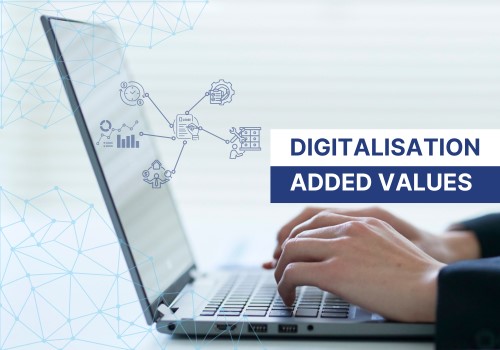Maintenance Focus 2023: The 6 Strategies To Highly Effective & Value Added Maintenance

When talking about facility and operation management, there is no doubt that maintenance management will make the difference in terms of adding or at least preserving value to the managed property.
Unfortunately, too often buildings which are well managed in terms of daily operations and security, see their market value drastically reduced because of poor maintenance!
What is, precisely, maintenance management, as first clarification? By the books, maintenance refers to tasks aiming to preserve the condition and efficiency of equipment and buildings while reducing breakdowns and increasing reliability. We are perfectly aware that in one building there are plenty of areas and situations where maintenance becomes strategically important but, that is not all! Different type of default or under performance of equipment, require different types of maintenance strategy!
We have grouped all the main equipment or events where maintenance is required in 5 main strategies, let’s go through together and identify the best one for each group of issues.
Breakdown Maintenance
This maintenance strategy has a 100% reactive approach to a “breakdown” event related to a piece of equipment. Breakdown maintenance is the most intuitive of all the strategies and has the main goal to rectify and fix a broken component or device within a specific equipment.
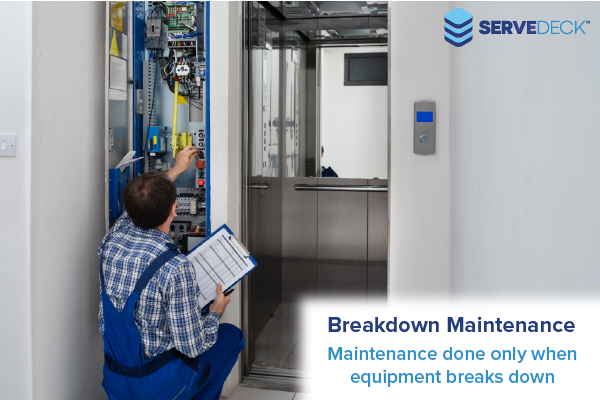
Being “reactive” means is totally unplanned and, as we can imagine, might be causing havoc in a busy office tower or shopping mall. The strategic side of this type of maintenance is brought in by the “intentionality” of letting an equipment run until it fails as it is easy and less expensive to fix or replace it, compared to having it under a scheduled maintenance cycle.
Corrective Maintenance
Corrective maintenance, even though still falls under reactive approach, is generated by casual findings during an unrelated inspection to a different equipment. Imagine, for instance, a technician completing a "Break-down Maintenance" work, finds one component, unrelated to the breakdown, having issues, and resolves them while completing the breakdown intervention.
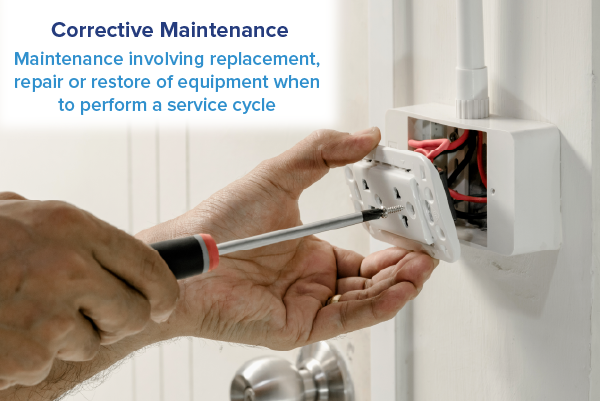
Corrective maintenance also falls under the unplanned actions group and cannot be considered proactive and is normally generating either an immediate solution or, if not serious or because of lack of spare parts, it might be generating a special work-order to be followed up in a later time.
Preventive Maintenance
A more proactive approach to maintenance management, defined as Preventive Maintenance, includes all activities related to servicing a piece of equipment before any issue or breakdown arises.
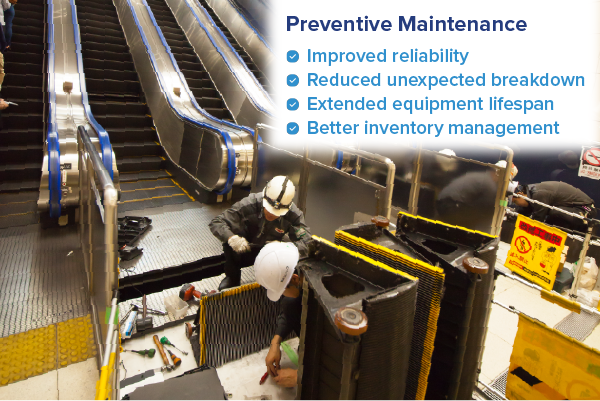
It includes routine cleaning, replacements, repairs, and inspections, it is either timeframe or usage planned and never occurs as an emergency. Both these maintenance scheduling ways are defined through an analysis of past breakdowns or through specific information given by the supplier of the equipment.
While preventive maintenance helps to substantially reducing “down-time” of equipment, is by many defined as too costly, not 100% effective and with plenty of room for improvement.
Predictive Maintenance
A more proactive way to address regular equipment maintenance is to predict issues and breakdowns and intervene before they happen. Predictive maintenance allows maintaining equipment using either their history (data collected from past breakdowns and regular maintenance cycles) or monitoring their performance by measuring key conditions, such as temperature, vibrations, or power consumption via sensors and remote monitoring, to timely predict when to start a servicing work cycle.
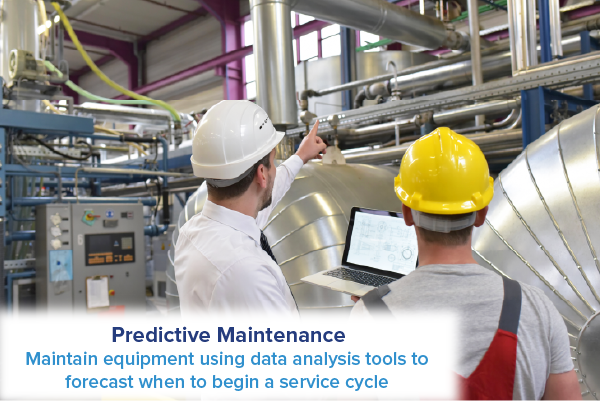
Predictive maintenance is anchored to widespread use of sensors and measuring devices collecting and transmitting data into a central device for processing. The service of predictive maintenance allows those applying it to focus on a more value-added task, generating higher ROI in terms of higher equipment reliability and reducing redundancy of maintenance work.
Predictive maintenance allows facility managers to focus on equipment efficiency and reliability with a substantial reduction of recurring costs of preventive maintenance or disruptive outcome of breakdown and corrective maintenance.
Prescriptive Maintenance
While predictive maintenance allows anticipating and resolving a possible issue before it happens, prescriptive maintenance, heavily using data collected by sensors and IoT or AIoT, enables facility and maintenance managers to find and fix what causes emergencies or issues.
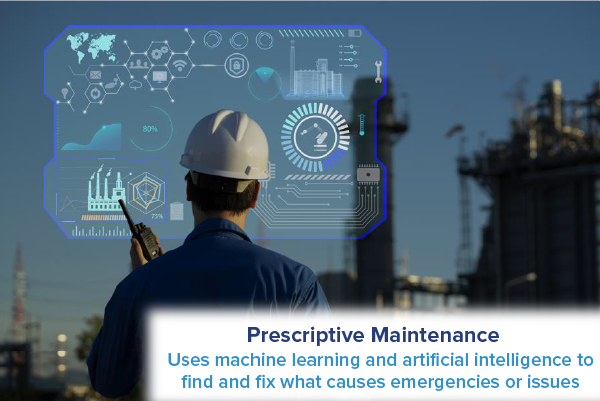
Prescriptive maintenance goes beyond analyzing historical patterns by focusing on what generates these patterns and identifying the cause of a breakdown and related emergency. Through a deep analysis of different datasets, collected by sensors, it correlates them to predict what is likely to come next, when it will happen and, prescribing the corrective action.
Prescriptive maintenance relies on artificial intelligence (AI) for the analysis and correlation of huge quantities of data collected by sensors and for the final prescription of maintenance cycles.
The main difference between predictive and prescriptive maintenance is that the first allows to avoid an impending failure or emergency while the second recommends the best way to avoid it through appropriate countermeasures. Applying a particular recommendation or "Prescriptive Maintenance" could result in extending the life expectation of an equipment far beyond the manufacturer prediction.
Of course, implementing prescriptive maintenance carries substantial investments and a precise costs/benefits analysis needs to be carried out before deciding about its implementation and, eventually, restricting it to the most valuable pieces of equipment.
This brings us to the last type of applicable maintenance strategy.
Reliability-Focused Maintenance
When the cost/benefits analysis is unfavorable to the implementation of prescriptive maintenance, facility and maintenance managers can apply a reliability-focused maintenance strategy by classifying the equipment according to their impact on the “well-being” of the building and its users.

An equipment reliability-focused approach will result in a mix of various maintenance strategies and related acceptable average equipment efficiency which will minimize risks while controlling costs.
Next comes the definition of how to choose the most appropriate maintenance strategy for the managed asset or building.
The choice of a maintenance strategy is a business decision which weights benefits, costs, and risks of each specific piece of equipment’s efficiency and failure. It all goes to a compare & contrast analysis of the Cost-Of-Doing-It versus the Cost-Of-Not-Doing-It.
As an example, and food for thoughts, a higher CapEx for the implementation of predictive and prescriptive strategies, generates a much lower OpEx in the medium-term and results in an extended lifespan for the equipment.
A "criticality assessment" is a valuable tool to qualify the criteria defining the severity of having a piece of equipment out of service.
The assessment should always consider these three areas of concern:
· Safety
· Quantitative impacts associated with maintenance costs
· Cost of repairing against the cost of replacing
A rule of thumb is to assess the quantity and quality of resources that makes sense to spend on each asset. The more critical the piece of equipment is to the good performance of your asset and the users’ safety and experience, the more makes sense to allocate technical resources and financial support for its maintenance. Check here what we have as available resources to help resolving your maintenance needs here.
ABOUT THE AUTHOR
.jpeg)
The opinions expressed in this article are solely of the author, Dr Daniele Gambero.
Dr Gambero has been an expatriate to Malaysia from Italy, since 1998 and has more than 35 years of real estate experience. He is the co-founder and group CEO of REI Group of Companies, the Co-founder of Propenomy.com and the deputy president of the Malaysia Proptech Association.
In the past 10 years Daniele, as international and TEDX speaker, has engaged several hundreds thousand people talking about Property, Economy, Propenomy, Digital Marketing and Motivation. He is also a bestselling author and columnist on several magazines and main stream media. You can reach him directly through his LinkedIn page here.
SHARE THIS POST:
Comments (0)
Leave a Reply
Your email address will not be published. Required fields are marked *



